West Virginia Wild: Crews Carve Out Corridor H Through the Appalachian Mountains
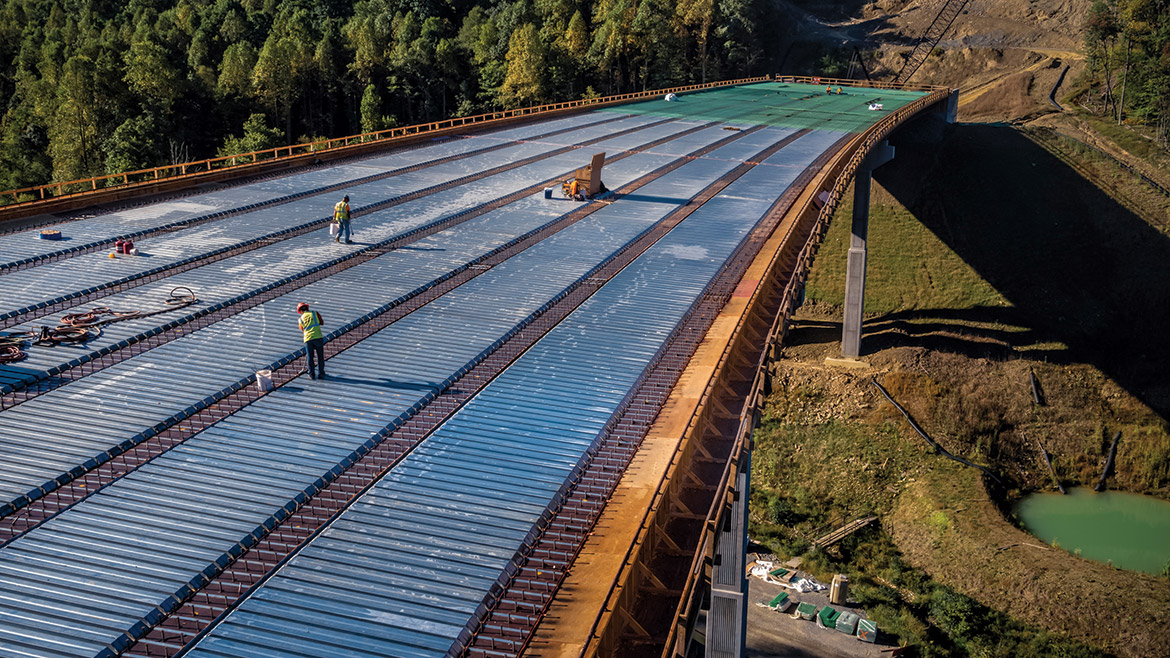
Corridor H is part of a bigger plan to better connect regions within the Appalachian range.
Photo courtesy of MBI
When crews with Kokosing Construction Co. began a $209-million design-build contract—the largest of its kind in West Virginia—in 2015, they first had to build roads in order to build the actual road called Corridor H.
“Initially getting to and into the project” was the first challenge, says Dave Mattson, Kokosing senior area manager, with access roads built through heavily forested areas and a mountain. “We were going up and down steep roads we created just to get to places. As you get there, it becomes a matter of riding on track equipment—getting rebar, concrete, piling, pipe and so on to the site.”
based in Westerville, Ohio, holds the design-build contracts for the first 7.5 miles of the 15.3-mile section and the second 4.5 miles, bid in 2019; the total contract value is now approximately $433 million. E.L Robinson Engineering, based in Charleston, W.Va., is the lead designer. Last year, A.L.L. Construction won an approximately $50-million, 3-mile job, and Triton Construction is preparing to build a $148-million, 3,300-ft-long bridge over the Cheat River. Other firms hold separate paving, grading and drainage contracts.
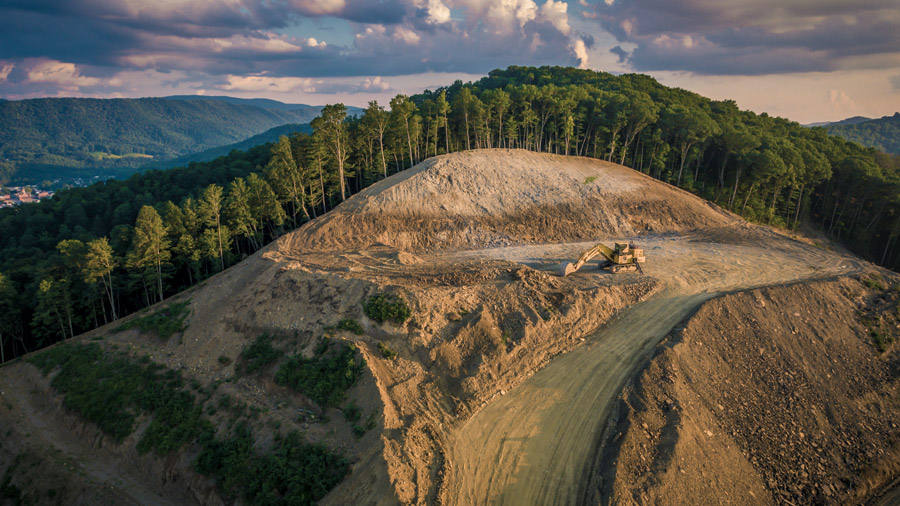
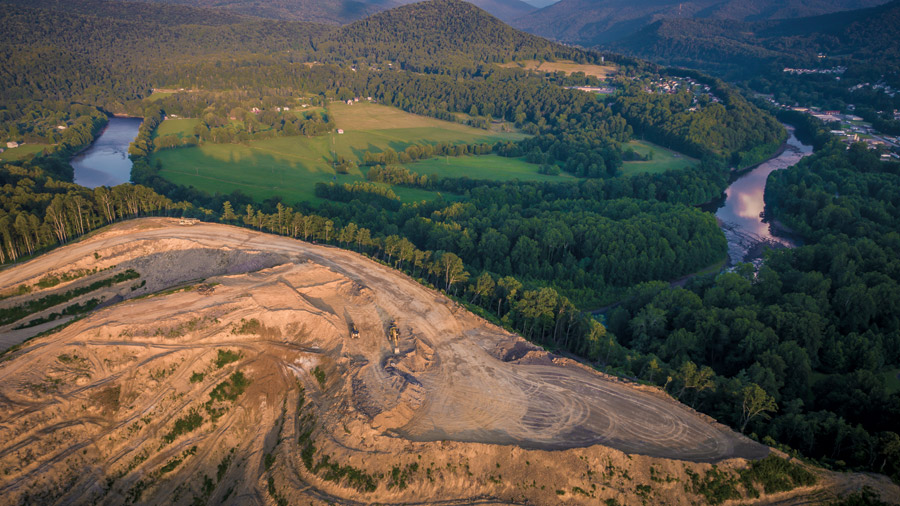
The Kerens to Parsons section of Corridor H under construction requires constant environmental monitoring in a national forest.
Photos courtesy of MBI
The sections under construction and future planned work are part of an overall 123-mile, four-lane highway, a half century in the making, taking shape through a national forest and the rugged Appalachians. Corridor H, also known as U.S. Route 48, when complete, will connect rural and largely isolated areas to key markets, including Washington, D.C.
The corridor, cited by Gov. Jim Justice (R) as the top construction priority for the state, is a product of the 1965 Appalachian Regional Development Act. Corridor H will be the only limited-access highway through West Virginia’s Appalachian Highlands region to Interstate 81 in Virginia.
The corridor symbolizes the state’s prioritization of infrastructure and economic development. In 2017, the West Virginia Dept. of Transportation and Division of Highways deployed the $2.8-billion Roads to Prosperity highway and bridge construction and maintenance program, the largest infrastructure investment in the history of the state.
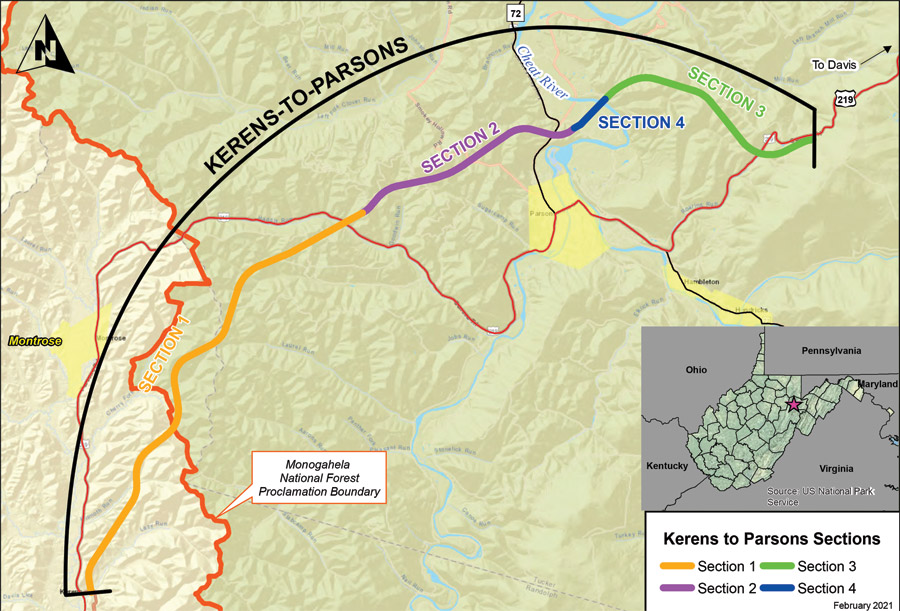
*Click the map for greater detail
The program invested in roads and bridges in every one of the state’s 55 counties. Residents voted to raise the gasoline tax, vehicle sales taxes and motor vehicle fees to go along with a series of bond sales aided by West Virginia’s strong credit rating.
Jimmy Wriston, secretary of WVDOT and commissioner of the West Virginia Division of Highways, recalls that the measure passed by more than 70%. “It was a grand slam,” he says.
Last year, the U.S. Dept. of Transportation released a total of $246.3 million from the Infrastructure Investment and Jobs Act to continue progress on the Appalachian Development Highway Program, of which Corridor H is a part. West Virginia received approximately $37 million. The system, also launched in 1965, includes 33 corridors totaling about 3,000 miles in 13 states from New York to northern Mississippi. About 85% of the system is finished, and DOT says the entire network is expected to be completed by 2040.
“This is the last piece for West Virginia, and the most important piece,” says Wriston. “We’re going to finish the road as quickly as humanly possible and open up the world to this part of the state.”
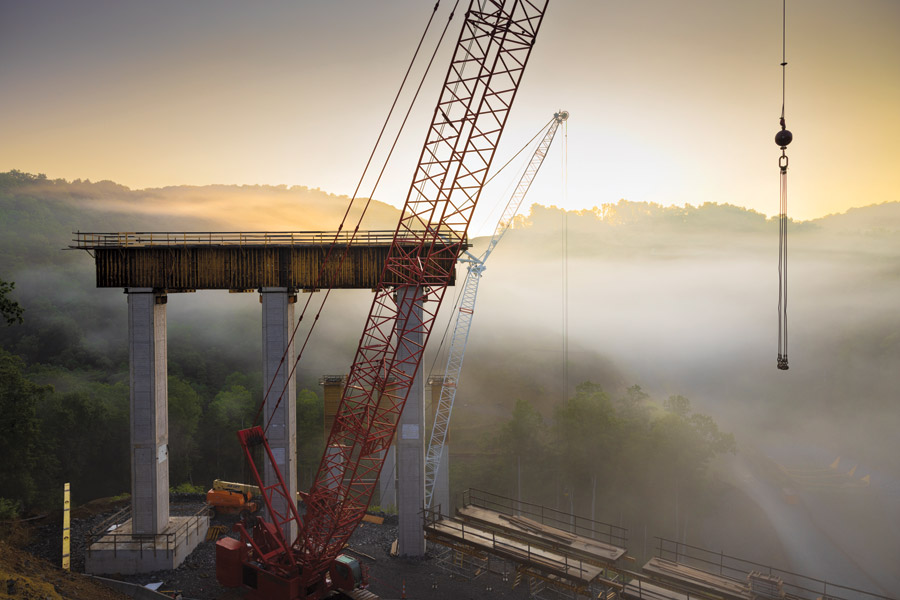
Crews build soaring bridges over valleys that typically contain wetlands or creeks.
Photo courtesy of MBI
Moving Forward
Corridor H’s first 40 miles were completed in the 1980s. Michael Baker International began working with the WVDOH in the 1990s as program manager, says Mohiuddin Shaik, program manager with MBI.
Much of the segment currently under construction is located within the Monongahela National Forest. Kokosing is building 11.5 miles of the alignment near Elkins toward SR 219, says Mattson. The first 7.5-mile portion has five bridges, with one due for completion in 2024. The longest bridge is 1,200 ft long, with piers as high as 230 ft. Overall, the work involves some 31 million cu yd of excavation.
“It took a lot of preplanning for access roads to stay within the confines of permitted areas and maintain percentage of grade our equipment could handle,” says Mattson. “A lot of excavation had to be engineered to build access roads properly. You don’t just cut into the hill and move on.”
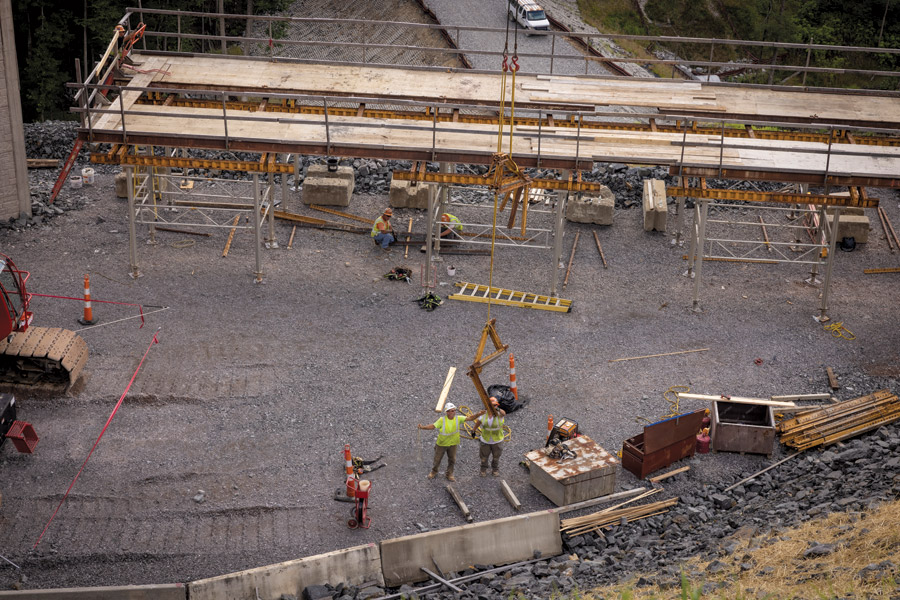
Other elements of design included rockfall catchment areas, waste areas, gas line relocation, right-of-way layout, major and minor drainage design, sediment and erosion control measures and aquatic organism passages with naturalized stream design, according to E.L. Robinson Engineering, which worked with Kokosing on the design.
Working through a construction season limited by weather, crews are performing earthwork with a maximum cut of 180 ft high and 320 ft wide, and a fill as high as 170 ft and as much as 110 ft wide, project officials say. Crews use temporary structures to span several streams to gain access to some sections.
Extensive studies and tests had to be carried out to assure stakeholders that one plant in particular, the whorled pogonia, would not be adversely affected by the new highway, notes Shaik. “The alignment had to be shifted a couple of times,” he says. The team used 3D shadow modeling to make sure the sun continued to shine on the whorled pogonia despite the construction of steel bridges that range from 560 ft to 1,200 ft in length and are up to 230 ft high.
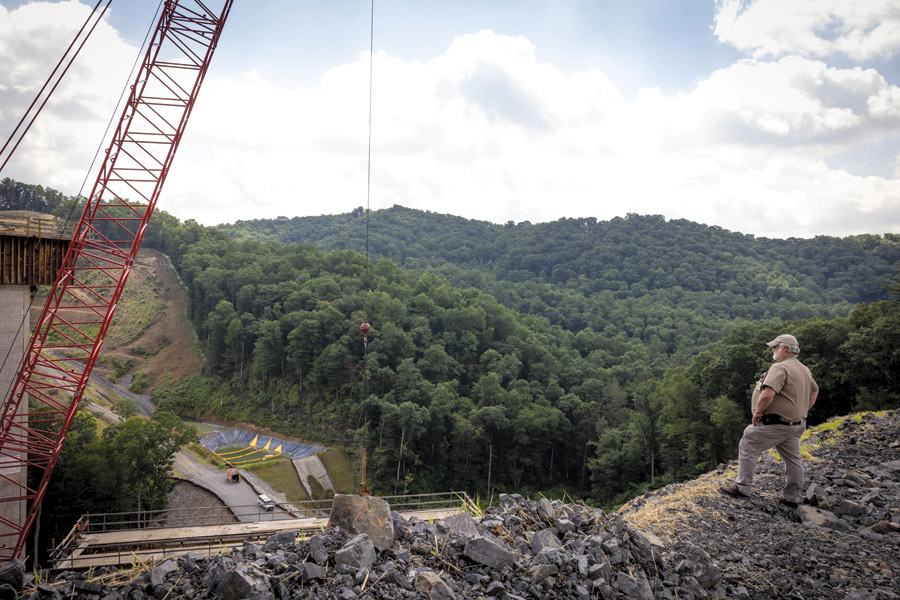
Jimmy Wriston, WVDOT secretary, surveys progress.
Construction last February won the contract to build the nearly 2/3-mile-long, 165-ft-high bridge over Cheat River as part of Section 4. It will soar over a vast floodplain and several homes and connect a 15-mile section of Corridor H between Kerens and Parsons with the portion from Parsons to Davis. It will be the department’s first best-value design-build contract.
The planned 650-ft main span “could potentially be a world record for plate girder bridges,” says Tommy Collins, Corridor H manager with WVDOT. The job will include some 600,000 cu yd of earthwork and 27 million lb of structural steel, with completion anticipated by early 2025.
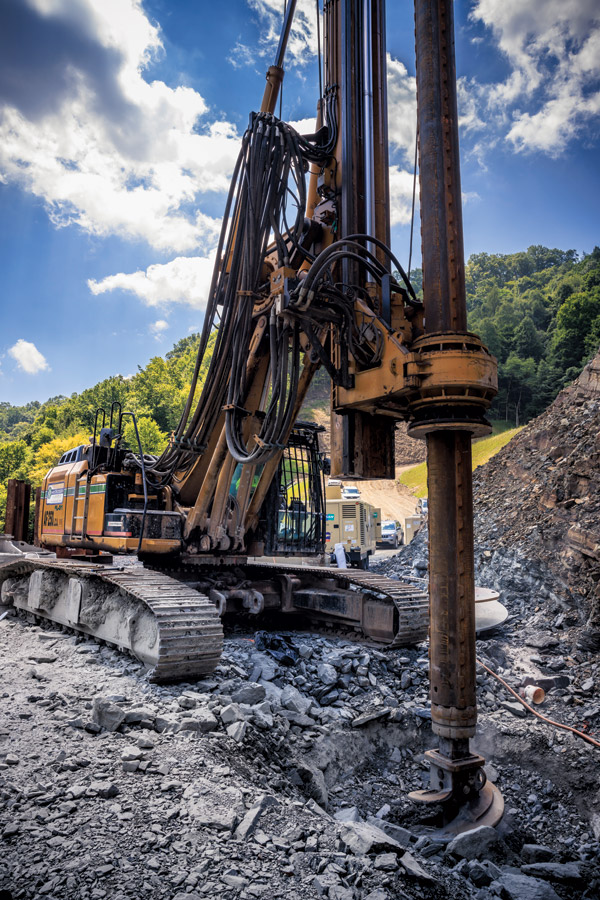
Massive amounts of earthwork must also be monitored to stay within permitted areas
A.L.L. Construction Inc., from Mount Storm, W.Va., was the lowest of five bidders for Section 3, with a bid of approximately $50 million. An additional 15%, or $7.5 million, will be added and set aside for erosion and sediment control to protect the environment.
The winning bid was less than the WVDOH’s engineering estimate of $71.7 million, including erosion and sediment control.
The contract calls for grading and drainage work for a 3.08-mile portion of the highway to be built from a starting point near the Cheat River Bridge. The contractor is expecting to move about 8 million cu yd of earth to make way for the road segment.
A couple of sections remain to be built. Design is beginning on a 6.8-mile section of Corridor H in Hardy County connecting Wardensville to the Virginia state line. Construction tentatively is scheduled to begin near the end of the decade. Another section is a 10-mile area between Parsons and Davis in Tucker County. Final design of this segment is anticipated in 2025, with construction tentatively scheduled to begin in 2031, according to the WVDOH.
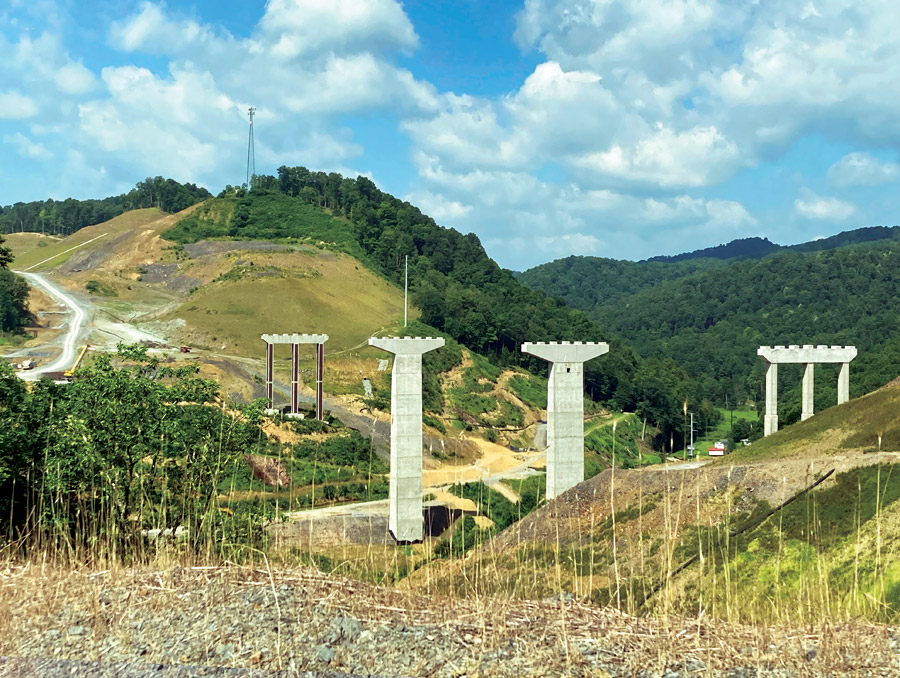
Bridges on the alignment can reach some 200 ft in height, crossing valleys and ravines.
Environment and Economics
Part of the future alignment is facing opposition. A petition started at Change.org objects to the building of Corridor H between the towns of Thomas and Davis, continuing to Douglas over the Blackwater Canyon Historic area.
“This plan would undermine the connection between the local communities and make it dangerous to travel between the towns on foot or bicycle,” says the petition. “An elevated four-lane highway through the beautiful Blackwater area is not in the interest of the local economy.”
The petition has received some 3,000 signatures. Residents fear that the planned route for the new highway would ruin some natural historic sites in the area, such as the rail trail to Douglas Falls, the historic coke ovens and the Blackwater Canyon Historic Area.
“Thomas and Davis have become destinations in the last 20 years with a thriving diversified economy. Directing commercial traffic traveling to locations outside the county through the center of our towns would have a detrimental impact on our businesses,” the petition adds.
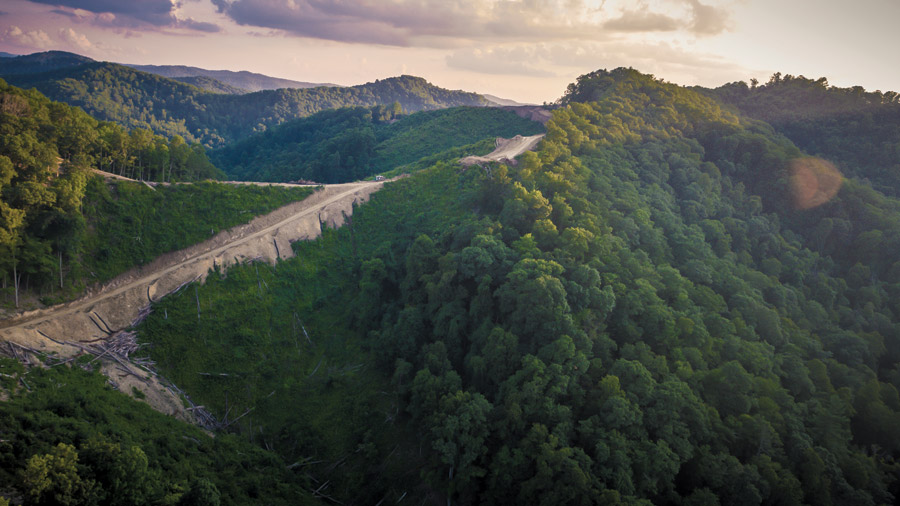
Building access roads robust enough to accommodate heavy equipment challenged construction crews.
In a December letter to the DOH, the West Virginia Highlands Conservancy advocated for a northern alignment alternative. “It will protect what has made this area an attractive destination for more visitors, residents and businesses. It will preserve the Blackwater Industrial Complex, a National Register-eligible historic district. It will avoid the scenic trails already open and to come.”
The organization along with the West Virginia Rivers Coalition urged DOH to consider a number of other issues, such as trout streams, truck traffic and acid mine drainage, as it continues the environmental permitting process.
The DOH contends that the proposed revised original proposed alternative, approved in 2007, remains preferable to the northern alignment because it is shorter, with less bridges, has 4.5 miles less impact on flora and fauna and avoids mine pools. “Additionally, a water quality treatment plant will be built upstream of the Coketon Bridge to improve water quality and habitats,” a DOH document states.
Local media reported that Wriston in a presentation to state lawmakers last fall stated: “If we’re serious about minimizing impact and serious about schedules, we can’t rethink these things. The preferred alignment we’ve chosen has the less impact, it’s the easiest and the most expedient to deliver. This is a small group of vocal people that is putting out a lot of disinformation simply to delay the project. The construction of Corridor H is inevitable; we are going to build that road.”
He also challenged the U.S. Fish and Wildlife Service’s desire that the possible presence of a type of bumblebee needs to be investigated further.
Wriston told ENR regarding the debate over the future segment: “We did our homework; we don’t want to go back.”
“This is the last piece for West Virginia, and the most important piece.” ~ Jimmy Wriston, WVDOT secretary, on finishing Corridor H.
On the entire Corridor H, WVDOH identified over 750 acres of wetlands. It has worked with various agencies to designate and protect large, high-value wetlands. According to the agency, only 37 acres of low-value wetlands will be impacted during highway construction. The mitigation process is completed in each design section of each construction contract for the corridor. About a dozen environmental agencies review and comment on the proposed mitigation plans and participate in field inspections as the plans develop.
In addition, the WVDOH has a full-time environmental monitor who reports monthly to the agency, ensuring that contractors are properly constructing, installing and maintaining required mitigation measures and erosion and sedimentation control measures.
“It’s beautiful, pristine terrain, and one of the most difficult areas in which to build a highway,” says Shaik. “Whatever is done on the project is to ensure the most environmentally acceptable option.”
WVDOT maintains that the project will open up remote areas in Grant, Tucker and Hardy counties to economic development and shorten travel times through the mountains, and that existing segments open to traffic have already made a difference.
“It’s a tremendous opportunity for the region, especially for Elkins, which is one of the largest cities in the area. The potential connector to Virginia, D.C. and Maryland and having that pipeline to bring people to experience the area is tremendous,” says Jerry Marco, mayor of Elkins. “We’re already seeing investments in the area. A hotel is being renovated, and a software company has selected us for a new location.”
Regarding environmental issues, Marco says the Division of Highways “has done a fantastic job of providing information to the public and everyone concerned. I don’t feel like I’ve been in the dark about anything. You won’t please everyone, but you have to look at the greater good of the state, and that new corridor to Virginia and Maryland is very important.”
The completion of Corridor H will also provide a more direct route from parts of West Virginia to Virginia and Washington, D.C., says Steve Roberts, president of the West Virginia Chamber of Commerce.
“Traffic is expected to increase exponentially, teeing up positive economic impacts for businesses, particularly for the communities of Elkins and Parsons,” he adds. “Businesses along this Appalachian Highway will benefit from increased exposure, opening up rural regions to economic development that will provide opportunities for generations to come.”
With Jim Parsons